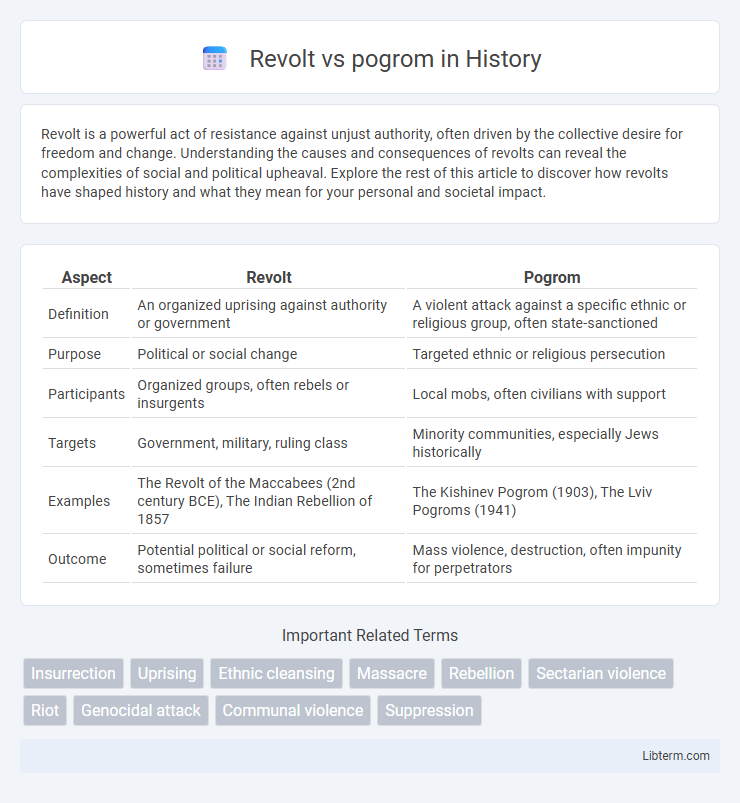Revolt is a powerful act of resistance against unjust authority, often driven by the collective desire for freedom and change. Understanding the causes and consequences of revolts can reveal the complexities of social and political upheaval. Explore the rest of this article to discover how revolts have shaped history and what they mean for your personal and societal impact.
Table of Comparison
| Aspect | Revolt | Pogrom |
|---|---|---|
| Definition | An organized uprising against authority or government | A violent attack against a specific ethnic or religious group, often state-sanctioned |
| Purpose | Political or social change | Targeted ethnic or religious persecution |
| Participants | Organized groups, often rebels or insurgents | Local mobs, often civilians with support |
| Targets | Government, military, ruling class | Minority communities, especially Jews historically |
| Examples | The Revolt of the Maccabees (2nd century BCE), The Indian Rebellion of 1857 | The Kishinev Pogrom (1903), The Lviv Pogroms (1941) |
| Outcome | Potential political or social reform, sometimes failure | Mass violence, destruction, often impunity for perpetrators |
Defining Revolt: Scope and Characteristics
A revolt is a localized or widespread uprising against authority, characterized by organized resistance aiming to challenge or overthrow existing power structures. It typically involves collective action, strategic planning, and explicit political or social objectives, distinguishing it from spontaneous violence. Revolts can vary in scale from small insurrections to large-scale movements, often driven by grievances related to oppression, inequality, or injustice.
Understanding Pogrom: Origins and Meaning
Pogrom refers to violent, organized attacks specifically targeting ethnic or religious minority communities, particularly Jews, historically characterized by killings, destruction of property, and social exclusion. The term originated in the Russian Empire during the late 19th century, deriving from the Russian word meaning "to wreak havoc" or "to demolish." Understanding pogroms involves recognizing their systemic nature, often state-condoned or tolerated, aimed at persecution rather than spontaneous resistance or rebellion seen in revolts.
Historical Examples of Revolts
Historical examples of revolts include the Haitian Revolution (1791-1804), where enslaved Africans rose against French colonial rule to establish the first Black republic, and the Spartacus Revolt (73-71 BCE), a major slave uprising against the Roman Republic. Unlike pogroms, which are attacks targeting specific ethnic or religious groups, revolts often involve organized resistance aimed at political or social change. The Indian Rebellion of 1857 also exemplifies a widespread revolt against British colonial power, highlighting collective action rather than targeted violence.
Notable Pogroms in History
Notable pogroms in history include the Kishinev pogrom of 1903, where violent anti-Jewish riots in the Russian Empire resulted in numerous deaths and widespread destruction of Jewish property. The 1881-1884 wave of pogroms across the Russian Empire followed the assassination of Tsar Alexander II, targeting Jewish communities with brutal attacks. The 1941 Lviv pogroms in Nazi-occupied Ukraine saw mass killings of Jews, marking a horrific chapter in the Holocaust and underscoring the deadly nature of state-supported ethnic violence.
Key Differences: Revolt vs Pogrom
A revolt is a collective uprising by a group or population against authority, typically driven by political, social, or economic grievances, aiming to challenge or change existing power structures. A pogrom specifically refers to violent, targeted attacks against a particular ethnic or religious group, usually involving massacres and destruction of property, often state-condoned or ignored. The key difference lies in intent and scope: revolts seek systemic change through organized rebellion, whereas pogroms are acts of persecution focused on terrorizing and eliminating minority communities.
Motivations Behind Revolts and Pogroms
Revolts are typically driven by political, social, or economic grievances, where oppressed groups seek systemic change or resistance against perceived injustice or authoritarian rule. Pogroms, in contrast, are motivated by ethnic, religious, or racial hatred, often resulting in targeted violence against minority communities, particularly Jewish populations. While revolts aim to challenge power structures, pogroms function as acts of collective punishment fueled by prejudice and scapegoating.
Social and Political Impacts
Revolt often signifies organized resistance challenging existing political structures, leading to significant shifts in governance or policy reforms, whereas pogroms denote violent massacres targeting specific ethnic or religious groups, resulting in deep social trauma and intensified communal divisions. Revolts can mobilize marginalized populations to seek systemic change, influencing political stability and social justice movements. Pogroms exacerbate ethnic tensions, perpetuate cycles of violence, and undermine social cohesion, often provoking international condemnation and influencing minority rights legislation.
Role of Authority: Response and Responsibility
In a revolt, authorities often respond with strategic negotiation or targeted suppression to restore order and address underlying grievances, reflecting a degree of political responsibility. In contrast, during a pogrom, authority figures typically exhibit complicity or active participation, failing to protect targeted communities and thereby enabling mass violence. This stark difference highlights how official responses to civil unrest can significantly influence outcomes, either mitigating or exacerbating social conflict.
Media Representation and Public Perception
Media representation of revolts often emphasizes political grievances and calls for justice, shaping public perception as legitimate resistance movements. In contrast, pogroms are typically depicted as violent, targeted attacks against minority groups, framing public perception around fear, victimization, and social division. The language and imagery used in media coverage significantly influence societal attitudes, either fostering empathy or deepening prejudices.
Lessons Learned: Preventing Future Violence
Understanding the distinct causes of revolts and pogroms is crucial for effective violence prevention strategies. Revolts often arise from systemic oppression and socioeconomic grievances, while pogroms typically stem from targeted ethnic or religious hatred. Implementing community engagement programs, promoting inclusive policies, and strengthening legal protections against hate crimes are essential lessons for mitigating future conflicts and fostering social cohesion.
Revolt Infographic

 libterm.com
libterm.com